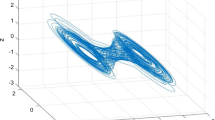Abstract
The development of fractional-order controller design methods having a few tuning parameters in the time/frequency-domain is an attractive research topic. There are a few design methods using time-domain specifications. Considering a Smith predictor structure, a simple and efficient analytical method to design a fractional-order controller for time-delay integer-order systems is proposed, in this paper. The design procedure is based on time-domain specifications. The design requirements are the percentage of overshoot and settling time. To achieve these requirements, several tuning formulas are derived based on ideal closed-loop transfer function. The main advantage of the proposed method is that it has only two tuning parameters, which can be obtained using an explicit set of tuning formulas. To demonstrate the performance of the proposed controller and to compare it with those provided by several well-known design techniques, the proposed design method is applied to two simulation examples. Finally, a robustness test is carried out considering plant uncertainties.













Similar content being viewed by others
References
Tavakoli S, Griffin I, Fleming PJ (2007) Multi-objective optimization approach to the PI tuning problem. IEEE Congr Evolut Comput doi:10.1109/CEC.2007.4424876
Kaya I (2003) Obtaining controller parameters for a new PI-PD Smith predictor using auto-tuning. J Process Control 13:465–472. doi:10.1016/S0959-1524(02)00086-0
Smith OJ (1959) A controller to overcome dead time. ISA J 6:28–33
Watanabe K, Ito M (1981) A process model control for linear systems with delay. IEEE Trans Automat Contr 26:1261–1269. doi:10.1109/TAC.1981.1102802
Ingimundarson A, Hägglund T (2002) Performance comparison between PID and dead-time compensating controllers. J Process Control 12:887–895. doi:10.1016/S0959-1524(02)00017-3
Chen YD, Tung PC, Fuh CC (2007) Modified Smith predictor scheme for periodic disturbance reduction in linear delay systems. J Process Control 17:799–804. doi:10.1016/j.jprocont.2007.03.003
Uma S, Rao AS (2016) Enhanced modified Smith predictor for second-order non-minimum phase unstable processes. Int J Syst Sci 47:966–981. doi:10.1080/00207721.2014.911385
Liu T, Cai YZ, Gu DY, Zhang WD (2005) New modified Smith predictor scheme for integrating and unstable processes with time delay. IEE Proc Control Theor Appl 152:238–246. doi:10.1049/ip-cta:20041232
Mataušek MR, Ribić AI (2012) Control of stable, integrating and unstable processes by the Modified Smith predictor. J Process Control 22:338–343. doi:10.1016/j.jprocont.2011.08.006
Lee D, Lee M, Sung S, Lee I (1999) Robust PID tuning for Smith predictor in the presence of model uncertainty. J Process Control 9:79–85. doi:10.1016/S0959-1524(98)00036-5
Albertos P, García P (2009) Robust control design for long time-delay systems. J Process Control 19:1640–1648. doi:10.1016/j.jprocont.2009.05.006
Normey-Rico JE, Camacho EF (2009) Unified approach for robust dead-time compensator design. J Process Control 19:38–47. doi:10.1016/j.jprocont.2008.02.003
De Oliveira V, Karimi A (2013) Robust Smith predictor design for time-delay systems with H\(\infty \) performance. IFAC Proc Vol 46:102–107. doi:10.3182/20130204-3-FR-4031.00012
Miller KS, Ross B (1993) An introduction to the fractional calculus and fractional differential equations. Wiley-Interscience, Hoboken
Oustaloup A, Mathieu B, Lanusse P (1995) The CRONE control of resonant plants: application to a flexible transmission. Eur J Control 1:113–12. doi:10.1016/S0947-3580(95)70014-0
Podlubny I (1999) Fractional-order systems and \(PI^{\lambda }D^{\mu }\)controllers. IEEE Trans Automat Contr 44:208–214. doi:10.1109/9.739144
Vu TNL, Lee M (2014) Smith predictor based fractional-order PI control for time-delay processes. Korean J Chem Eng 31:1321–1329. doi:10.1007/s11814-014-0076-5
Boudjehem D, Sedraoui M, Boudjehem B (2013) A fractional model for robust fractional order Smith predictor. Nonlinear Dyn 73:1557–1563. doi:10.1007/s11071-013-0885-9
Feliu-Batlle V, Pérez RR, Garcia FC, Rodriguez LS (2009) Smith predictor based robust fractional order control: application to water distribution in a main irrigation canal pool. J Process Control 19:506–519. doi:10.1016/j.jprocont.2008.05.004
Feliu Batlle V, Rivas-Perez R, Castillo Garcia F (2005) Fractional robust control to delay changes in main irrigation canals. IFAC World Congr 38:28–33. doi:10.3182/20050703-6-CZ-1902.02095
Castillo-Garcia FJ, Feliu-Batlle V, Rivas-Perez R, Sanchez L (2011) Time domain tuning of a fractional order PI\(\alpha \) controller combined with a smith predictor for automation of water distribution in irrigation main channel pools. IFAC Proc Vol 44:15049–15054. doi:10.3182/20110828-6-IT-1002.03138
Castillo-Garcia FJ, Feliu-Batlle V, Rivas-Perez R (2013) Time domain tuning of fractional order controllers combined with a Smith predictor for automation of water distribution in irrigation main channel pools. Asian J Control 15:819–833. doi:10.1002/asjc.558
Oustaloup A (1995) La dérivation non entière. Hermes, Paris
Bode HW (1945) Network analysis and feedback amplifier design. Van Nostrand, New York
Barbosa RS, Machado JT, Ferreira IM (2004) Tuning of PID controllers based on Bode’s ideal transfer function. Nonlinear Dyn 38:305–321. doi:10.1007/s11071-004-3763-7
Monje CA, Vinagre BM, Feliu V, Chen Y (2008) Tuning and auto-tuning of fractional order controllers for industry applications. Control Eng Pract 16:798–812. doi:10.1016/j.conengprac.2007.08.006
Maâmar B, Rachid M (2014) IMC-PID-fractional-order-filter controllers design for integer-order systems. ISA Trans 53:1620–1628. doi:10.1016/j.isatra.2014.05.007
Saidi B, Amairi M, Najar S, Aoun M (2015) Bode shaping-based design methods of a fractional order PID controller for uncertain systems. Nonlinear Dyn 80:1817–1838. doi:10.1007/s11071-014-1698-1
Author information
Authors and Affiliations
Corresponding author
Rights and permissions
About this article
Cite this article
Safaei, M., Tavakoli, S. Smith predictor based fractional-order control design for time-delay integer-order systems. Int. J. Dynam. Control 6, 179–187 (2018). https://doi.org/10.1007/s40435-017-0312-z
Received:
Revised:
Accepted:
Published:
Issue Date:
DOI: https://doi.org/10.1007/s40435-017-0312-z




